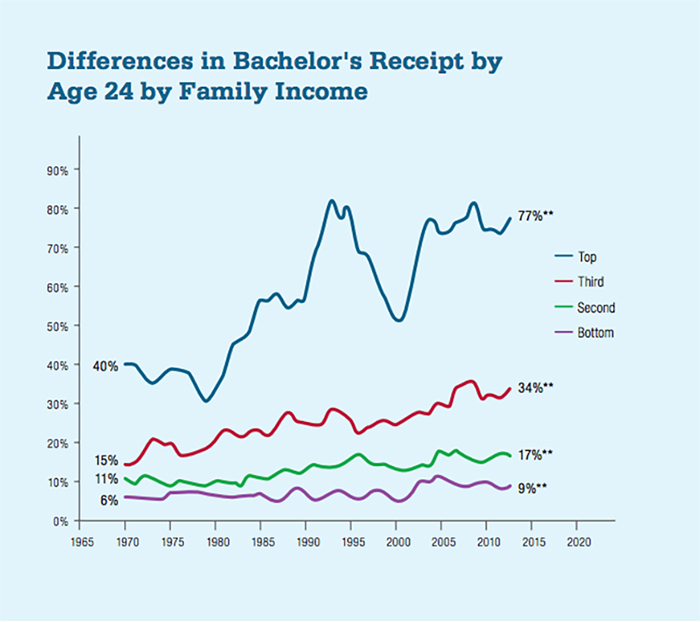Why America’s Top Charter Schools Are Looking Beyond the High School Diploma to Better Track and Support Alumni Through College Graduation

Last July, The 74 partnered with journalist Richard Whitmire in launching The Alumni — a special multimedia project that surveyed new efforts underway at America’s largest charter school networks to guide students and alumni both to and through college.
Featuring interviews with network leaders, support staff, graduates, and current students, it was a first attempt to capture these schools’ campaigns to raise the bar in how they define success, as well as their focus on providing additional support for teens long after they have left campus.
Whereas many districts focus primarily on high school graduation rates, there is now a commitment among many charter leaders to look beyond that first diploma and to focus more attention on measures of college persistence and completion.
In other words, they began to more closely track what percentage of their student body goes on to complete college within six years.
Whitmire’s most widely cited chapter from the summer of 2017 examined new statistics that showed the number of charter school alumni who had gone on to complete college within the six-year time frame. While the national college graduation rate for low-income students of color is 9 percent, Whitmire documented that top charter networks were seeing alumni from similar backgrounds graduating at three to five times that rate.
In terms of developing policies to track and support graduates, perhaps no network has been as rigorous as KIPP Public Charter Schools, which now follows new high school students from their first day of ninth grade through the end of their college careers. (In the case of KIPP middle schools, the tracking begins even earlier.)
In the year since we first launched the project (we’re still accepting alumni stories and testimonials right here), we’ve covered many other developments about charter networks graduating their first senior classes, and more charter alumni transitioning to college campuses. Three of our most-read recent headlines:
● New Orleans: In the aftermath of Katrina-inspired school reforms, report shows New Orleans students are now more likely to attend — and graduate from — college (Read the full story)
● New York City: As Success Academy graduates its first class of 16 college-bound seniors, don’t bet against it someday being thousands (Read the full story)
● Texas: A superintendent celebrates as all 849 seniors are graduating — and 590 are the first in their families to enroll in college (Read the full essay)
To see Richard Whitmire’s complete yearlong research project, visit and bookmark The Alumni microsite right here. (You can also get the latest statistics on college attendance and completion data delivered straight to your inbox by signing up for The 74 Newsletter.)
In case you missed them, here were the eight most-read chapters from the first year of The Alumni:

1 Exclusive: Data Show Charter School Students Graduating From College at Three to Five Times National Average
At top schools that primarily serve low-income students, graduates are going on to complete college at three to five times the national average. Take a deeper look at the numbers here.
2 KIPP NYC College Prep: Tracking Students Through College Like No One Else in America
No one tracks their high school graduates into and through college like KIPP. And just a day at KIPP NYC College Prep in the South Bronx explains how KIPP has made such rapid gains in its college success rate: In a college prep class for juniors, KIPP alumni from two different colleges came to tell the highs and low of college life. Read the full profile.
3 WATCH: Closing the Opportunity Gap for College — F&M College Prep
4 Green Dot Public Schools: Not Just About Getting Students Into College, But Getting Them Into the Right Ones — and Keeping Them There
The Los Angeles-based Green Dot Public Schools has always been unique. Unlike many CMOs, Green Dot initially launched as a high school; unlike many CMOs, Green Dot takes on tricky turnarounds like Locke High School in L.A.’s Watts neighborhood. In recent years, the network has been highly successful at getting all of its high-poverty graduates on a college track and admitted to college, and it now says it’s focusing on issues of college persistence and completion. Read the full profile.
5 Georgetown Scholarship Program: Getting First-Generation Students Acquainted to College Early On
Many universities have been slow to accommodate first-generation college attendees, unaware of the special supports some of these low-income and minority students need. But at Georgetown University, things are done a little differently. Richard Whitmire explores an inspiring initiative in the nation’s capital, where a special scholarship program is designed to guide first-generation college students through the intimidating waters of the prestigious university. Over the past 12 years, the program has grown to 650 students, providing advice, mentoring, and additional grants, usually for expenses that don’t fit into the primary scholarship — things like dental and eye care, emergency trips home for a funeral, and the return trip to Georgetown. Read the full article.
6 IDEA Public Schools: ‘Proving the Impossible Is Possible in South Texas’ by Striving for Both Bigger and Better
Richard Whitmire traveled to the Rio Grande Valley, where IDEA’s charter schools sit along the U.S.-Mexican border in McAllen, Texas. In those schools, where many students cross the border every day to go to class, 35 percent of the alumni are graduating from college in spite of significant financial and cultural obstacles. Read the full profile.
7 Must-See: At Newark’s North Star Academy, 100% of the Graduating Class Is Going to College
8 Achievement First: Where Just Doing Better Than Its Peers Isn’t Enough, Network Sets Its Sights on Lofty 75% College Success Rate
Despite seeing its alumni graduate from college at a rate above average for its student demographics, Achievement First is still reaching higher: The network with schools in New York, Connecticut, and Rhode Island wants to hit a 75 percent college success rate in the long term. Read the full story.
Follow the latest updates and read our new profiles and testimonials at TheAlumni.The74Million.org.
Get stories like these delivered straight to your inbox. Sign up for The 74 Newsletter

;)
